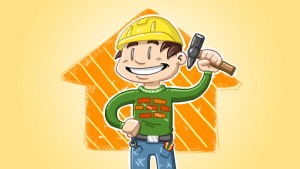If you are like Nick you are saying it’s just easier to pay someone to take care of this because I have no idea on what I am doing. Well this can become very costly, really quick. It can be intimidating and seem to complex, but over the years we have learned so much in doing some things ourselves that wound up saving us in the long run.
Simple Home Maintenance Tips
Toilets
Water leaking toilets tank will not only cost you money every month in the utility bill, but it can cause damage to your bathroom floor and wear out the internal parts of your toilet. A simple trick is to add red colored food dye in the water tank of your toilet. Check back in an hour or so and see what color the water in the tank is. If it is pink, you have a leak. To replace flapper; turn off water valve, which is normally right behind toilet. Remove the lid and flush the toilet to empty the tank out. Use a towel or sponge to mop out any excess water left in the tank. Remove the flush chain from the lever and then slide the old flapper off the overflow tube. Slide new flapper in place, reconnect the chain and then turn water back on.
Washing Machine and Dryer
Regularly checking your washing machine water supply for leaks is so important. One of the top reasons for insurance claims is for water damage caused by supply lines that are leaking. You should inspect the lines at least once a year and replace them at a minimum of every three years if they are plastic. When checking you notice the metal ends are discolored or rusty, replace them immediately.
You should also check to ensure that the drain lines are tightened properly. A pair of pliers or crescent wrench. You should not be able to tighten any further if the line is properly tightened.
With regards to the dryer, it is important to always make sure you regularly clean your lint screen in order to prevent fires. This will also increase the life of the heating element. You can also remove any fabric softener residue by washing the screen in warm water and dish detergent every week or two.
Air Conditioning
Air Conditioners are normally one the most overlooked appliances when it comes to regular maintenance. And one of the mostly costly when it comes to getting them repaired.
You will want to regularly check the condensation line where the water comes out of the house and make sure that you can see water freely flowing from the line. This will ensure that the line is not clogged. If this is not occurring you can attach a Shop VAC to the line and turn it on for 3-5 minutes and attach it to the drain line. You will hear if anything comes out and then remove the Shop VAC and you should notice that the water is flowing freely again.
Air Filters
Change the Air Filter in your central air and heat often, especially during the peak usage months. Usually 30 days in longest you want to go between changing the filters. Nick puts it on the calendar with the sizes we have in our house, so if he is out he always has the sizes available.
We use the cheap fiberglass filters; which are actually preferred as opposed the HEPA filters for the following reasons: 1. it is more cost effective to use the cheaper ones. 2. The fiberglass filters actually allow for more air flow into the climate controlled unit which will reduce the amount of energy used to effectively cool or heat your home.
Refrigerators
Door Seals are the main thing that you should keep an eye on. By doing this you will reduce the amount of energy it takes to keep your food cool or frozen. This will also keep you refrigerator working more efficiently and prevent premature wear on internal parts.
Easy test for your door seal. Use a dollar bill and close the door on the bill. Then attempt to pull it out with the door closed. If you cannot easily pull the bill out, then your seal is in good shape. If the bill slides out easily, it is time to replace the seals. This is something you can purchase at any local hardware store. Recommendation before heading out the door, take a picture of the tag which has make, and model number of your refrigerator so you show the sales person. This will prevent you from making multiple trips.
If you have a refrigerator with coils along the back, it is recommended that you periodically vacuum the coils to remove dirt and dust build up. The coils contain the coolant that the refrigerator uses to keep the inside temperature cold. If they are dirty, they will not work the way they are supposed to and your refrigerator may stop keeping your food cold.
Hopefully we have given you some very simple DIY tips that even a novice person can accomplish. It really is all about routine maintenance. Which could wind up saving you big money in the long run. Especially if you are considering selling your house. Remember a buyer will do a home inspection and lack or routine maintenance can add up real quick. Please check back regularly as we are always updating our site with good to know information. Feel free to email us any comments or questions to NickandCindyDavis@TampaHomesSold.com













